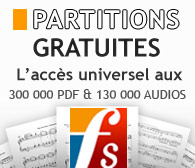| Beethoven, Ludwig van - "Adagio Cantabile" for Woodwind Quartet Opus 13 No. 8 Quatuor à vent: Flûte, Hautbois, Clarinette, Basson |
VoirPDF : "Adagio Cantabile" for Woodwind Quartet (6 pages - 147.46 Ko)3 301x⬇ VoirPDF : Basson (70.38 Ko) VoirPDF : Bb Clarinette (71.94 Ko) VoirPDF : Flûte (73.86 Ko) VoirPDF : Hautbois (74.21 Ko) VoirPDF : Conducteur complet (110.02 Ko) MP3 : "Adagio Cantabile" (Opus 13 No. 8) for Woodwind Quartet 879x⬇ 8684x
Adagio Cantabile for Woodwind Quartet
MP3 (1.65 Mo) : (par Magatagan, Mike)178x⬇ 651x| Compositeur : | Beethoven, Ludwig van (1770 - 1827) | ||||
| Instrumentation : | Quatuor à vent: Flûte, Hautbois, Clarinette, Basson | ||||
| Genre : | Classique | ||||
| Arrangeur : Editeur : | MAGATAGAN, MICHAEL (1960 - ) | ||||
| Date : | 1798 | ||||
| Droit d'auteur : | Public Domain | ||||
| Ajoutée par magataganm, 11 Janv 2013 Ludwig van Beethoven's Piano Sonata No. 8 in C minor, Op. 13, commonly known as "Sonata Pathétique", was written in 1798 when the composer was 27 years old, and was published in 1799. Beethoven dedicated the work to his friend Prince Karl von Lichnowsky. Although commonly thought to be one of the few works to be named by the composer himself, it was actually named Grande sonate pathétique (to Beethoven's liking) by the publisher, who was impressed by the sonata's tragic sonorities. Prominent musicologists debate whether or not the Pathétique may have been inspired by Mozart's piano sonata K. 457, since both compositions are in C minor and have three very similar movements. The second movement, "Adagio cantabile", especially, makes use of a theme remarkably similar to that of the spacious second movement of Mozart's sonata. However, Beethoven's sonata uses a unique motif line throughout, a major difference from Haydn or Mozart’s creation. The Adagio movement opens with a famous cantabile melody. This theme is played three times, always in A-flat major, separated by two modulating episodes, making it a five-part rondo. The first episode is set in F minor (relative minor of A-flat major), further modulating to E-flat major before returning to the main theme. The second episode begins in A-flat minor and modulates to E major. With the final return of the main theme, the accompaniment becomes richer and takes on the triplet rhythm of the second episode. Although originally written for Piano & Orchestra, I created this arrangement for Woodwind Quartet (Flute, Oboe, Bb Clarinet and Bassoon) from a transcription for Solo Piano. Partition centrale : | Sonate pour Piano No.8 en Do mineur (Pathétique) (48 partitions) | | |||
Par chessermesser, 12 Janv 2021 à 21:13
Hey, I really like what you did with this piece. magataganm  , 12 Janv 2021 à 21:20 , 12 Janv 2021 à 21:20 ↪ Thank You! I'm glad you like it in this form |
© 2000 - 2024
Accueil - Nouveautés - Compositeurs
Mentions légales - Version intégrale









